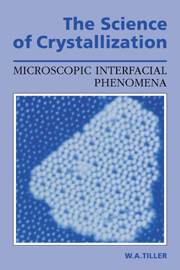Book contents
Preface
Published online by Cambridge University Press: 13 February 2010
Summary
This book is one of two companion books on the science of crystallization and both are meant to be teaching vehicles rather than scientific treatises although some parts get close to the line. They are intended to develop a student's understanding of all the interwoven processes that are involved in either the natural geological formation of crystals or in the tailor-making of crystals in the laboratory for a specific use. Although the specific techniques used in the laboratory are many and extremely varied, the basic atomic processes involved are quite similar. Thus, it is felt that a basic description of the processes involved in any one specific technique allows ready extrapolation to the understanding of other techniques.
In this book, many of the experimental examples will relate to crystallization from the melt; however, examples and applications are also given to show how these same principles may be used to understand crystallization from all other nutrient media. In some cases, we will be more interested in the corollaries “Under what conditions does amorphous deposition occur?” and “What is the dissolution rate?”. We shall see that these same principles and ways of thinking allow us to consider the more general case of “phase transformations,” whether the path is to a crystalline or to an amorphous product (e.g., the formation of an SiO2 film on Si during thermal oxidation).
- Type
- Chapter
- Information
- The Science of CrystallizationMicroscopic Interfacial Phenomena, pp. xiii - xviPublisher: Cambridge University PressPrint publication year: 1991

